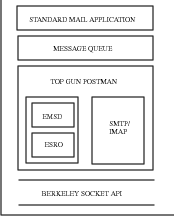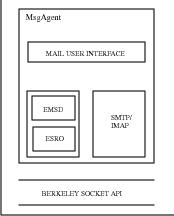LEAP on Palm OS
LEAP on PalmOS
| Document Number: | PLPC-100008 [ .bib ] |
| Version: | 0.3 |
| Dated: | September 21, 2001 |
| Group: | LEAP |
| Primary URL: | http://www.freeprotocols.org/PLPC/100008 |
| Federated Publications: | ByTopic -- ByContent |
| AccessPage Revision: | This AccessPage was produced on April 09, 2013 at 2:42 PDT (-0700) |
| Author(s): | Mohsen BANAN |
| Organization: | Free Protocols Foundation |
AVAILABLE FORMATS
- PDF: -- 100K -- Provides the document in Portable Document Format.
- PS: -- 600K -- Provides the document in Postscript format for printing.
- HTML: -- 76K -- Displays the document as a web page.
SHORT
DESCRIPTION
This article provides a technical description which describing the architecture and implementation of LEAP on Palm OS devices.
LEAP on Palm OS
Mohsen Banan
http://mohsen.banan.1.byname.net/ContactMe
First Published: September 21, 2001
Last Updated: October 2, 2001
Copyright ©2001 Mohsen Banan
copies of this manual provided the copyright notice and
this permission notice are preserved on all copies.
A Component of The LEAP Manifesto
This article is one of a series of articles describing various aspects of the Mobile Messaging industry and the Lightweight &
Efficient Application Protocols (LEAP) protocols. For the complete collection of articles see The LEAP Manifesto [?], available
at
http://www.LeapForum.org/LEAP/Manifesto/roadMap/index.html. The LEAP Manifesto is also available at the Free
Protocols Foundation website at
http://www.FreeProtocols.org/LEAP/Manifesto/roadMap/index.html.
Contents
1.1 LEAP on Open-Source PDAs
1.2 Palm OS Integration Strategy
2 Palm OS Mail User Agents
2.1 Separate Mail User Interface and Mail Transport Service
2.2 Integrated Mail User Interface and Mail Transport Service
3 Invitation to Participate
List of Figures
2 Example of Combined Mail Transfer Service for Palm OS
1 Introduction
This is one of a series of articles that describes the implementation and integration issues involved in incorporating the LEAP protocols into particular PDA environments.
The starting point for incorporation of LEAP in PDAs consists of the Mobile Messaging application, and is based on the Efficient Mail Submission and Delivery (EMSD) protocol [?]. EMSD is the e-mail component of the LEAP family of protocols [?].
A complete description of how EMSD provides everything necessary to enable end-users to benefit from true end-to-end open mobile messaging based on patent-free protocols and open source and free software is provided in the article Operation Whiteberry [?]. The present article is part of the more general Operation WhiteBerry model. Before reading this article, the reader is strongly encouraged to read Operation Whiteberry so that he/she has a clear understanding of the general implementation framework.
It is our goal to make LEAP widespread on all PDAs. However, the incorporation of LEAP into each platform follows a particular approach and strategy. Each of the articles in this series outlines our strategy for a specific platform.
Windows CE Integration Strategy
A standard mail application called Inbox is bundled with all Windows CE devices. Microsoft has defined a generic mail transport service provider interface underneath Inbox, which allows alternative mail submission and delivery protocols to be integrated with Inbox. Microsoft has also defined a winsock interface which provides access to UDP[?] and TCP[?] by third party applications. These well-defined APIs allow a new mail submission and delivery protocol to be integrated with Inbox in the Windows CE environment.
Our strategy for integration of EMSD in the Windows CE environment has been to provide a complete Mail Transport Service provider underneath Inbox. We have done so by providing EMSD binary distribution packages which end-users can quickly and easily plug in, allowing immediate implementation of the WhiteBerry model.
Additionally, the entire source code package for EMSD on Windows CE is available subject to the Gnu General Public License (GPL). The availability of this software package in source form allows tight integration with wireless modems, and other customizations/enhancements.
The existing open-source implementation is available at http://www.mailmeanywhere.org.
1.1 LEAP on Open-Source PDAs
It is highly desirable that there exist complete open-source and free software platforms as alternatives to the commercial PDA platforms such as Windows CE and Palm OS.
At the present time two such open-source platforms are “Linux Based PDAs” and “eCos.” Recently there have been numerous announcements of new Embedded Linux support for PDAs and other handheld personal computing devices. Various suitable eCos platforms are also now in place.
See the article LEAP on Linux PDAs [?] for more details.
1.2 Palm OS Integration Strategy
Palm OS is an effective, general purpose mobile computing platform which, among other applications, comes bundled with a simple e-mail application called Mail. In contrast to the Windows CE Inbox application, however, the standard Palm OS mail application has only a very rudimentary set of features and capabilities. Also in contrast to Windows CE, the Palm OS does not include a set of well defined APIs to facilitate the integration of alternative mail protocols.
To complicate matters further, various third party mail user agents have now become widely available for Palm OS (largely because of the limitations of the standard Palm OS mail application), with a variety of different user interfaces. Because of this multiplicity of incompatible Palm OS mail applications, each integration of LEAP with Palm OS must be specific to a particular Palm OS mail user agent.
For these reasons our strategy for integration of the EMSD protocol engine in the Palm OS environment is different from that for Windows CE.
We start with a very basic example implementation of EMSD for Palm OS. This example implementation is specific to the standard mail application, based on file access.
Based on the availability of this package in source form, subject to the Gnu General Public License, a variety of Palm mail user agents can become EMSD-enabled very rapidly. To accomodate this further we have selected certain mail user agents which we consider particularly desirable, and we will participate in the integration of EMSD with these mail user agents.
2 Palm OS Mail User Agents
There are two basic alternative approaches to developing an e-mail application in the Palm OS environment. These are:
- Separate Mail User Interface and Mail Transport Service
- Integrated Mail User Interface and Mail Transport Service
Our goal in this article is to accommodate incorporation of EMSD as a Mail Transport Service provider in both models.
2.1 Separate Mail User Interface and Mail Transport Service
In the separate mail user interface and mail transport service model, the application is split into two parts. One part is responsible for transferring the mail message, while the other part is responsible for processing and displaying the message.
An example of this approach is the standard Palm Mail application. The basic distribution of Palm OS lacks mail transport services such as SMTP[?], POP[?], or IMAP[?]. It normally depends on its desktop synchronization capabilities to accomplish the actual sending and receiving. Messages written by the user are put into a queue; then upon synchronization with the desktop, the desktop counterpart sends the queued messages and also retrieves received messages.
However there are add-on packages, such as Top Gun Postman [?] that provide SMTP and POP/IMAP support within the Palm OS device. This enables users of the standard Mail application to send and receive messages directly from their devices via a wireless modem.
Incorporation of EMSD into packages such as Top Gun Postman can be rapidly accomplished as an add-on or replacement for SMTP/POP/IMAP. Figure 1 shows the components involved as well as the layering of services in this model.
For example, the incorporation of EMSD support with Top Gun Postman can be very quick and easy because of the availaibility of EMSD protocol engines as a Palm OS library.
2.2 Integrated Mail User Interface and Mail Transport Service
In the integrated mail user interface and mail transport service model, the application is entirely self-contained.
There are numerous examples of this approach, since it offers greater convenience of operation and usage in the Palm OS environment. In particular MsgAgent [?] and DoodleMail [?] are very popular clients.
Figure 2 shows the components involved and the layering of services.
For example, the incorporation of EMSD support with MsgAgent can be very quick and easy because of the availaibility of EMSD protocol engines as a Palm OS library.
3 Invitation to Participate
As described in Operation WhiteBerry, the incorporation of EMSD in Palm OS mail packages presents enormous benefits.
We invite the developers of Palm OS mail application packages to incorporate EMSD into their software. EMSD protocol engines ready for the Palm OS environment are readily available, and can be easily integrated with your software. Complete implementations of EMSD in open-source form are available at http://www.mailmeanywhere.org.







